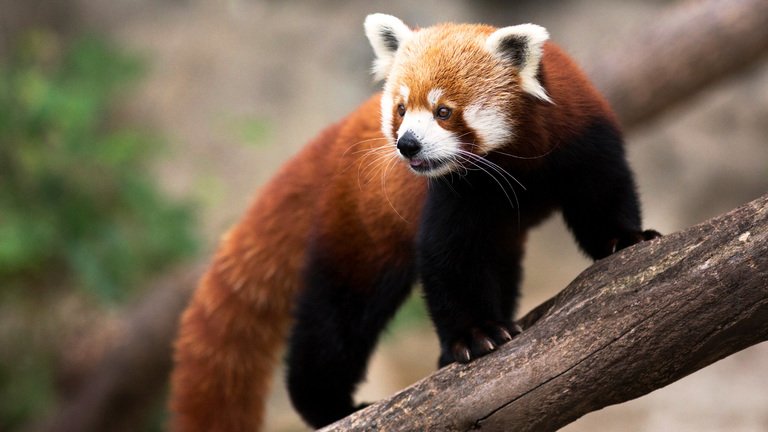
Red pandas are not your typical “dangerous” animals like lions or bears, but understanding their behavior and environment can help clarify how they interact with humans. Picture this: you’re in a cozy café, sipping your favorite drink, and suddenly you’re drawn to a playful puppy. Cute, right? But if that puppy feels threatened, it could nip at you. Similarly, red pandas can be unpredictable, and knowing their nature is crucial for anyone who might encounter these charming creatures.
Understanding Red Panda Behavior
Red pandas are known for their playful and sometimes quirky antics. They’re mostly solitary animals, preferring to hang out alone or with one other panda during mating season. If you think of a red panda as a laid-back roommate who mostly enjoys their own space, you’re on the right track. They’re not naturally aggressive, but their wild instincts still simmer just below the surface.
Here’s the thing: red pandas have sharp claws and teeth, which they use for climbing trees and eating bamboo—one of their favorite snacks. If a red panda feels cornered or threatened, it might use those claws and teeth as a defense mechanism. So, while they’re not out looking for trouble, you definitely don’t want to surprise them. Just like you wouldn’t poke a sleeping bear, it’s best to admire these creatures from a safe distance.
You might be wondering what triggers their defensive behavior. Common culprits include loud noises, sudden movements, or unfamiliar scents. Think about how you might react if someone sneaks up on you. If you’re startled, you might flinch or react defensively; red pandas can do the same. It’s all about their natural instinct to protect themselves.
Are There Any Recorded Incidents?
Incidents involving red pandas and humans are rare, but they do happen. Most encounters are benign and often include people observing these animals in zoos or wildlife sanctuaries. However, there have been instances where zookeepers or researchers have gotten too close for comfort, leading to minor injuries from bites or scratches.
In one case, a zookeeper in a wildlife park was conducting a routine check when a red panda, feeling cornered, nipped her hand. The injury was minor and quickly treated, but it does highlight an essential point: even the most lovable animals have their limits. When working with wild animals, it’s crucial to respect their boundaries and give them space.
Honestly, most red panda interactions are positive and rewarding. People leave zoos with memories of these quirky creatures swinging from branches or snuggling together. But understanding that their cuteness doesn’t equal total harmlessness is vital. They still deserve respect and caution.
How to Safely Observe Red Pandas
If you’re excited about seeing red pandas in real life, there are some important safety tips to keep in mind. The most effective way to enjoy these adorable animals is from a distance, preferably in a well-structured environment like a zoo or nature reserve. Here are some ways to do it safely:
- Respect the Enclosure: Always stay behind barriers and follow zoo guidelines.
- Stay Calm: Avoid sudden movements or loud noises that could startle them.
- Watch for Signs: If a red panda shows signs of discomfort, like pacing or hiding, give it space.
You might think of observing a red panda like going to a concert. You enjoy the performance from the audience, where it’s safe, rather than rushing the stage. The same rule applies here; keep your distance, and you’ll have a memorable experience without putting either you or the panda at risk.
Another great option is to take part in organized tours or educational programs at zoos that focus on animal behavior. These programs often include guidelines on how to interact with these creatures—usually through glass or at a safe distance. It’s a wonderful way to learn more while respecting their natural instincts.
Red Pandas: Nature’s Cuddly Ambassadors
Despite their occasional defensive behaviors, red pandas play an essential role in their ecosystems and serve as ambassadors for wildlife conservation. They help spread seeds through their diets, contributing to the lush forests they inhabit. Their charm and unique quirks make them a favorite among many, but they also remind us of the importance of respecting wild animals.
Think of red pandas as tiny, furry ambassadors for their environment. They might look like they belong in a children’s storybook, but they’re part of a complex ecosystem that relies on their natural behaviors. By observing them thoughtfully, we can celebrate their role in the wild without causing them stress.
Conservation efforts for red pandas are crucial too. With habitat loss and poaching on the rise, these charming creatures face many challenges. Learning about them helps us understand why protecting their environment is vital. And when we appreciate animals like the red panda, we become part of a larger movement to keep nature’s balance intact.
The Bottom Line: Know Before You Go
In conclusion, while red pandas aren’t generally dangerous to humans, it’s important to recognize that they are wild animals. Their behavior can be unpredictable, especially if they feel threatened. Observing them in a safe environment, respecting their space, and learning more about their natural habits can help keep both you and the panda safe.
So, next time you spot a red panda on your screen or in the zoo, remember that behind their cute exterior lies a wild spirit deserving of respect and understanding. They’re not out to harm us, but caution and awareness go a long way in ensuring everyone has a positive experience—especially these adorable, fluffy creatures.

